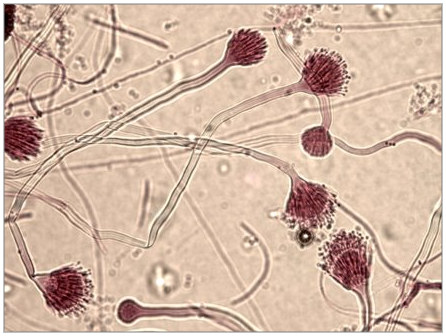The Last Of Us: Fungal Infection Readily Overlooked As Significant Cause Of Human Disease
13 March 2023
Fungal infection is readily overlooked as a significant cause of human disease, limited to irritating superficial infections of the skin, hair and nails or mucosal membranes (thrush), with severe disease only occurring in those with an existing underlying condition or immunosuppression. While this is broadly applicable, the sheer scale of human fungal infection goes relatively unnoticed. Globally, more people die from fungal disease than they do from Malaria and tuberculosis, with fungi showing an acute ability to exploit emerging situations.
In the 1980s HIV pandemic, Pneumocystis pneumonia and Cryptococcal meningitis were two of the main AIDS defining diseases, and remain so to date. More recently, the COVID-19 pandemic has highlighted the fragility of the human species to novel infectious diseases, and various fungal genera (Aspergillus, Candida, Mucorales) have been identified as a regular secondary complications in patients with COVID-19. Worryingly, as we move beyond the COVID-19 pandemic, it appears 20% of patients with influenza requiring critical care management will develop secondary infection with Aspergillus and 50% of these patients will die.
It is evident that there is an ever increasing clinical population at risk of fungal infection, but could we ever be at risk of a fungal pandemic that threatens existence as we know it? Well, the recently released Sci/Fi Horror series “The Last of Us” utilizes the environmental fungus Ophiocordyceps unilateralis, an insect pathogen that infects and controls the behaviour of ants to benefit proliferation of the fungus itself, as a human pathogen leading to a “zombie” apocalypse. Now, this scenario is exceptionally unlikely to happen outside of a fictional world, but could fungal infection pose a realistic threat to human existence?
It has been hypothesized that fungi played a role in the extinction of the dinosaurs. At the end of the carboniferous period, extensive levels of decaying organic vegetation may have lead to high levels or airborne fungal spores, and being cold blooded animals dinosaurs would be prone to fungal respiratory infection. Indeed, over the past century 72% of animal species that are extinct or face regional extirpation events have been targeted by a specific fungal pathogen. But humans, like all mammals are warm blooded and this limits the opportunity for fungi to become infective. True, but so are bats and certain species, such as the little brown bat, face a 99% of regional extinction due to the aptly name fungus Geomyces destructans.
In an era of environmental change, governed by increasing temperatures, inevitably exposes environmental fungi to higher growth temperatures and possibly limits antifungal efficacy if fungal membrane composition is changed in response to higher ambient temperatures. Higher global temperatures leads to changes in the natural environment, potentially leading to deforestation and desertification, initially providing an excess organic food source but eventually increasing the ranges of fungi endemic to those areas and increasing opportunity for contact with humans.
An ever increasing human population continues to place strain the Earth’s resources. Fungicides are extensively and increasingly used in agriculture to protect crop yields from plant pathogens, but the same class of antifungal agents are widely used in agriculture and the clinic, leading to increased rates of antifungal resistant disease in patients, associated with 70% mortality. Unfortunately, we have not learned from our previous mistakes and this practice continues, compromising the efficacy of novel antifungal drugs.
While clinically we must focus on obligate pathogens, we should not overlook the potential impact of opportunistic fungal pathogens. Originating from the natural environment, fungi do not require a host to survive and has been demonstrated in the animal kingdom, if they become pathogenic exhausting that food source is subsequently not a concern. Furthermore, given their ubiquitous environmental and frequently airborne range, regular exposure to fungi is inevitable, and should a species such as Aspergillus fumigatus become a true human pathogen then global airborne dispersal would be inevitable and exposure to the pathogen could not be prevented through isolation.
With an increasing global population the denominator of people prone to fungal disease will inevitably rise, but clinically the increased use of corticosteroids and immunomodulatory therapies are increasing the range of susceptible patients beyond the established cohorts. With environmental and agricultural practices driving problematic changes in fungal epidemiology and the same fungi causing disease in humans, it is critical that we develop a “One Health” Strategy for the management of fungal disease and antifungal resistance.
- Blog by Professor Lewis White
Professor White recently joined the Centre for Trials Research as an Honorary Professor jointly with the Division of Infection and Immunity at Cardiff University.
- June 2024
- May 2024
- April 2024
- March 2024
- December 2023
- November 2023
- September 2023
- July 2023
- June 2023
- April 2023
- March 2023
- February 2023
- December 2022
- November 2022
- October 2022
- September 2022
- August 2022
- July 2022
- June 2022
- May 2022
- April 2022
- March 2022
- February 2022
- January 2022
- November 2021
- September 2021
- July 2021
- June 2021
- May 2021
- March 2021
- February 2021
- December 2020
- November 2020
- September 2020
- August 2020
- July 2020
- January 2020
- December 2019
- October 2019
- September 2019
- July 2019
- June 2019
- May 2019
- April 2019
- February 2019
- December 2018
- November 2018
- October 2018
- September 2018
- August 2018
- July 2018
- June 2018
- May 2018
- April 2018
- March 2018
- December 2017
- October 2017
- August 2017
- July 2017
- June 2017
- May 2017
- April 2017
- March 2017
- February 2017
- January 2017
- December 2016
- October 2016
- August 2016
- June 2016
- April 2016
- March 2016
- February 2016